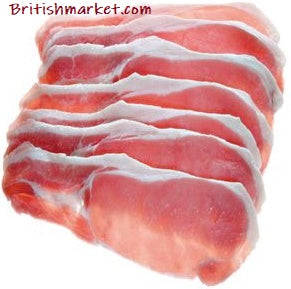This is a frozen item.
The Total Weight of your Frozen Order has to be a minimum of 6lbs
You can mix & match frozen food
This item has a ship weight of 1/2 lb.
Requires Styrofoam Box and Dry Ice
Krown Danish back bacon makes breakfast worth eating again. Great as a bacon butty.
Smoked, grilled, or fried, these Danish sliced-back bacon rashers are a budget-friendly ingredient to your everyday scrumptious breakfast. These rashers are perfect for a classic British fry up!
Danish bacon is cut from the loin of the pig, differentiating it from American bacon, which is cut from the pig's belly. In Britain, a slice of Danish bacon is usually referred to as a rasher. A very popular British dish containing the meat is a bacon butty, or bacon sandwich. The popularity of this bacon in the United Kingdom can be traced back to the mid-1800s, when the Danish began exporting pigs to the region in a strategic economic move that led to one of Denmark's major exports: pigs.
Ingredients:
Pork Loin cured with water, salt, sugar, sodium ascorbate, and sodium nitrite
Nutritional Information:
- 2 Skillet fried slices (23g)
- Servings per container: 10 to 12 – 2 rashers per serving
- Calories 35
- Calories from fat 17.5
How to Cook Krown British Style Sliced Back Bacon
- Remove the back bacon from the packet and pat away excess moisture.
- Preheat a griddle or heavy-based pan.
- No need to season this meat as it is already cured.
- Add a few rashers on the griddle or pan – do not overcrowd.
- Snipping the rind halfway down with a pair of kitchen scissors prevents the bacon from curling.
- Cook the bacon over high heat and turn only after the side has been caramelized. Each side of the bacon needs to be cooked for approximately 2 minutes or till they are sizzling.
Did You Know?
Bacon from the Germanic root “-bak,” and is referred to as the meat which comes from the back of the pig. When it migrated westward, where it became a dish worthy of contemporary gourmets. The Romans called it ‘petaso’. They made it by boiling salted pig shoulder with figs and finally used pepper sauce to season it. For the French ‘bakko’ became ‘bacco’ and soon, in the 12th century, it was adopted by the English, who called it ‘bacoun’. During that period, the term was used for all types of pork products. However, by the 14th century, people began referring to ‘bacoun’ as cured meat.
This item has a ship weight of 1/2 lb.












